How to make and install a stainless steel chimney with your own hands: step-by-step instructions
Until recently, the chimney pipe was predominantly made of brick, sometimes with asbestos-cement or cast iron inserts. Chimney ducts can be welded from sheet steel. But practical experience shows that the best solution would be a stainless steel chimney.
It will cost more than asbestos-cement channels, but assembling a pipe made of alloy steel is much simpler than the brick version. At the same time, the service life of stainless steel chimneys when installed correctly is quite long; it is limited only by the quality, thickness of the metal and reliability of fastening.
The content of the article:
Kinds
All steel chimneys are made modular or stacked, that is, a chimney pipe of the required length and configuration can be assembled from separate sections (modules) of a standard size. Often stainless steel is installed inside a duct made of heat-resistant ceramics, bricks, blocks made of mineral wool, if the chimney duct is made inside a wooden building.
From the point of view of the operating conditions of the chimney, a modular system is not very good, since each additional joint is a risk of leakage of hot gases or air leakage, which reduces draft in the chimney duct.
To equip the chimney, two types of stainless steel sections are used:
- single-layer or more often called single-circuit;
- sandwich pipes or double-circuit sections.
In addition to straight modules, to assemble a stainless steel chimney you will need a significant number of transition sections, elbows with a flow rotation of 30-90O, tees, adapters from a larger diameter to a smaller one, couplers, clamps and, of course, a roof or ceiling passage unit.

In the best case, corrugation is used to make a transition on a moving section of a wall, roof frame or ceiling. In those places where a rigidly fixed section of the chimney can be torn due to shrinkage and movement of wooden roof structures.
Healthy: Fan in the chimney to improve draft.
Single-circuit
Due to mass advertising, most users have the not entirely correct opinion that sandwich pipes are the only possible, universal solution for stainless steel chimneys. But it is not so.
Single-circuit chimney pipes have certain advantages over sandwich structures:
- Light weight and simple assembly, which does not require careful adjustment of the joints between sections.
- Low price, a single-circuit stainless steel pipe costs 2.5 times less than a sandwich. It can be cut with a grinder, scissors, or a cutting machine, adjusting the section to length.
Sometimes individual pieces of pipe have to be welded semi-automatically or with argon in order to build up or make a chimney of an individual shape. And this is extremely important for correctly adjusting the length of individual sections, turns and corner areas.
Important! In order for the draft in the stainless steel chimney duct to remain consistently high, without dips and reverse drops, it is necessary to prevent more than three sections in the chimney with a flow rotation (deviation from the vertical).

The diameter of one end is 1-2 mm larger than the size of the second. That is, stainless steel sections can be placed on top of each other; the number of such joints in one chimney is limited only by the height of the chimney pipe and the stability of the structure.
Sometimes individual sections of a stainless steel pipe are made as a continuous section without seams. Several modules are welded into one seamless one, 2-3 m long. Usually this is a straight vertical section. This part of the chimney is used as a heat source for the attic or living room on the second floor of the building. Welding is necessary in order to avoid opening of joints and leakage of gas combustion products from wood or coal through the locks.

Welded single-circuit structures are also used in the first (lower) sections of chimneys of steel sauna stoves.Double-circuit sandwiches often cannot withstand high heat. The surface of the stainless steel is heated by flue gases to 500-600OWITH.
Basalt thermal insulation can withstand more, but at this level of heating the joints between sections begin to separate. Therefore, in order not to get burned in the steam room, the owners prefer to join the first, hottest section of the chimney (above the heater) by welding.
But such a scheme has one major drawback - stainless steel has a high coefficient of thermal expansion. If the chimney section is assembled from separate sections, then the increase in pipe length due to overheating of the stainless steel is compensated by gaps on the locks.
But if you install one long solid section of pipe 2-2.5 m long, then the total extension can be large, which can lead to the opening of a joint somewhere under the ceiling.
This is where the seams on the chimney most often come apart. As a result, hot gases leak under the ceiling and the ceiling lining may burn.

Dimensions and material of single-circuit chimneys
The diameter, section height and width of the landing belt have long been brought to a single standard. For the installation of chimneys in private houses, bathhouses, and summer kitchens, sections with a diameter of 100 mm to 200 mm are used.
The width of the belt is 50 mm. Wall thickness - 0.8-1.6 mm. The most popular sizes are from 140 mm to 200 mm.Stainless steel chimneys of larger diameter are practically not used in private homes.
In addition to round ducts, sections of “oval” pipes can be used for the chimney. In advertising they are often called ellipsoidal or oval, but in fact the cross-section of such a module is close in shape to a rectangle with rounded corners.
Why is this so important? Because when calculating the characteristics of a stainless steel chimney pipe, you need to know exactly the cross-sectional area of the channel. For round and ellipse shapes, the lumen area can be easily calculated using the formula. In oval chimneys, the cross section is determined with a large error.
Stainless steel chimney pipes assembled from sections of oval cross-section are difficult to install along the outer wall of the house. Wind loads must be taken into account correctly. Although, if you plan and assemble all the sections correctly, an oval stainless steel chimney will work no worse than a regular round one.

The durability of the chimney directly depends on the grade of stainless steel. A metal can vary greatly in properties depending on the content of alloying additives. This is the biggest problem for single-circuit stainless steel chimney pipes.
If you need a chimney for a sauna heater, then you need to choose heat-resistant stainless steel with a high chromium content. For external ducts laid along the external wall of a house, corrosion-resistant grades are usually chosen. It is difficult even for a specialist to distinguish stainless steel by appearance, so when purchasing sections, the grade of metal must be verified using documents.
As a rule, double-circuit sandwich pipes do not have this problem. The outer cladding is most often made of black or inexpensive low-alloy steel. To give it the appearance, it is plated with chrome and polished to a high shine. The internal channel can be made of high-quality corrosion-resistant X18H9T or its equivalent. But you can check the metal only by cutting at the end of the section.
Sandwich pipes
Each section of the sandwich chimney is a double stainless steel pipe, one nested inside the other. Thermal insulation made of basalt fiber is pressed into the wall between them.
The design of the end locks of each sandwich section is designed so that there is no air gap between the thermal insulation of the two sections in which moisture can accumulate. In addition, some stainless steel sandwich chimneys are additionally equipped with a condensate removal system, which significantly affects the service life of the thermal insulation.
If you install a chimney without taking into account the flow of condensate, the thermal insulation layer will greatly absorb moisture and often sag inside the wall. At the same time, the outer and inner walls of the stainless steel chimney remain intact and can still serve for decades. You have to disassemble each section and manually change the thermal insulation.
Sandwich pipe is ideal for making a chimney inside the house. It is clear that it is recommended to use high quality sections for the internal chimney pipe.
Important! The first and main requirement for sandwich pipes is proper welding of stainless steel. A simple single-circuit chimney for a potbelly stove can be made from a sheet of stainless steel literally on a table or “on your knee.”If we are talking about a chimney duct for a solid fuel boiler, then a double-circuit sandwich pipe with a longitudinal weld seam made end-to-end with a laser or argon torch should be used.
The quality of metal and welding must be confirmed by certificates. It is not recommended to install riveted pipes or models with a rolled seam on high-capacity heating boilers. Otherwise, all the fumes and soot will collect inside the thermal insulation and drain as condensation along the outer surface of the cladding.
There are two ways to connect sandwich sections:
- By flue gases. This means that the lower edge of the upper section of the pipe is flared and is placed over the lower part when joining.
- By condensate. In this case, the upper end of the lower section has an extended flare and the upper part is inserted into it like into a bowl. This is done so that condensation products do not leak through the seam onto the outer surface of the chimney pipe.
Docking along “flue gases” is done in order to avoid leakage of combustion products through the joint between two stainless steel sandwich modules. If the connection at the junction is loose, then the flue gases will suck in air and carry it up the chimney channel.
They will not get inside the premises. Typically, this type of connection is used to remove relatively light and volatile combustion products from the chimneys of gas boilers.
The condensate scheme is used when burning wood, coal or briquettes. Such flue gases contain a lot of tar, soot, and phenol-water condensate. They are very hot, the draft in a stainless steel chimney is very strong. But at the same time, the amount of condensation and soot falling on the walls increases by an order of magnitude.Therefore, it is necessary at all costs to avoid leakage of liquid at the locks and to force it to flow down the walls to the condensate collector.
How to make a chimney from stainless steel
The specific layout of the chimney duct, its dimensions, the line of passage through the floors and roof are selected depending on the design of the boiler. If the boiler is gas, usually with an upper outlet flange, then the chimney can be made combined. This means for one-story buildings the pipe will be assembled from single-circuit and double-circuit sections.
Installation Rules
When planning a chimney for a gas boiler, you must follow several basic rules:
- the chimney pipe must have its own fastening, and in no case rest on the ceiling or parts of the roof frame (roofing pie);
- the section of the chimney when passing through the ceiling or roofing must be made of a double-circuit sandwich section;
- a fungus and a deflector are placed on the head of the chimney.
The last point is required only for gas boilers. For stainless steel chimneys installed on solid fuel boilers, fungus is not installed. A deflector is installed instead.
Stainless steel chimney design
This is a classic version of a chimney pipe for a boiler using network methane gas. The structure consists of two sections. The first (lower) is made of a single-circuit pipe, goes from the boiler to the mounting bracket, made of AISI304 stainless steel 1 mm thick.
Next comes a reinforced type adapter with welded additional elements-ears. With their help, the chimney can be securely fixed to a metal frame (wall bracket). The upper part of the chimney is assembled from stainless steel of the same brand, with both pipes: internal and external.Steel thickness - 0.8 mm.
Why was this design chosen? The main part of the combustion products of methane or propane is hot water vapor, carbon dioxide and air nitrogen. The exhaust is very clean, moderately hot and quite light.
The inner walls of the stainless steel chimney channel are practically not overgrown with soot. Therefore, the lower part of the chimney can be made of single-circuit stainless steel. And everything higher will have to be insulated in order to maintain draft in the channel.
A tee is inserted between the adapter and the single-circuit stainless steel; it will be needed for cleaning the chimney.
Assembly instructions
The design has 8 joints, each of which can “play” in the width of the mutual overlap by several millimeters. It may turn out that after assembling the lower single-circuit part, installing the transition cone and sandwich, this entire part simply will not fit into the gap between the boiler and the roof of the house.
Therefore, before assembling the inside of the chimney, all parts are laid out on the floor in the required sequence and joined together without rigid fixation. This is necessary in order to once again check the height of the inside of the chimney and calculate the level of fastening of the bracket with a loop on the wall.
Next, the sandwich pipe is assembled, and the hot part of the chimney duct is placed inside the lining. After that, fixing inserts are installed; they will prevent the insulation from falling out after the work is completed.
A cone adapter is placed on the lower edge of the sandwich.
Important! The fitting assembly of the chimney is carried out dry; during final installation, all joints must be additionally sealed with heat-resistant sealant.
The next stage is to assemble a single-circuit section of the chimney.Now you can put the previously assembled section of the sandwich with a cone and tee on top, and then secure the parts with stainless steel clamps.
Only after this will it be possible to apply markings on the wall for attaching the bracket.
The steel frame with the hinge is attached to the wall as is, without disassembling the previously assembled part of the chimney.
Now you need to determine the location for drilling a hole on the roof for the passage unit. To do this you need:
- fix the lower part of the chimney with a loop on the bracket;
- Unscrew the locking nut on the bracket hinge;
- align the lower part vertically using a building level or plumb line.
- After alignment, the nut on the bracket loop is tightened, and the outline of the future hole for the passage unit is drawn along the upper edge of the pipe with a pencil.
Since the boiler is relatively cold, the temperature of the outer cladding is quite low, the passage unit can be made simple from a stainless steel sheet, insulated with a layer of basalt thermal insulation and glued to the roof sheathing from the inside of the room.
Before installing the pass-through assembly, you need to put a clamp on the top of the sandwich. With its help, it will be possible to fix the junction of the lower part of the chimney with the upper part leading to the roof.
Before the flipper and mushroom are put on, the entire structure is checked again using a building level. If necessary, the position of the stainless steel chimney can be adjusted by rotating the lock nut on the bracket hinge.
If the height of the chimney above the roof is more than 170 cm, then you will need to put on an additional clamp with “ears” and secure the pipe with guy wires.
Features of installing stainless steel chimneys for solid fuel fireboxes
For solid fuel heating boilers, the requirements for chimney installation are much stricter.Firstly, it is necessary to equip an inspection and a collection tank for condensate. Secondly, the entire chimney structure must be double-circuit in the lower part (from the boiler to the ceiling) and preferably insulated in the area from the passage unit to the upper section of the pipe.
It is clear that the temperature of the flue gases inside the chimney duct is much higher than that of gas boilers. Therefore, the entire chimney system must be assembled from high-quality heat-resistant stainless steel.
For solid fuel boilers, the outlet is traditionally made from the rear (rear) wall. This is a special solution for a solid fuel firebox, taking into account the installation of a tee and then the entire stainless steel chimney. That is, a tee at the outlet of the boiler will be needed to clean soot, and there will also be a glass below for collecting condensate. This is the only way to protect the boiler furnace from water and resinous substances condensing on the stainless steel.
For a boiler with a power of 18-25 kW, a chimney with a sufficiently large cross-section will be required. Typically, a sandwich with an internal channel with a diameter of 180 mm and an external channel with a diameter of 280 mm is selected. This is for chimneys with a height of at least 8 m. For more modest sizes of 5-6 m, the diameter of the pipe must be increased.
One more thing - the efficiency and durability of a stainless steel chimney on a solid fuel boiler largely depends on the temperature of the exhaust gases. For example, if on the return pipe of the heating circuit) the water temperature is at least 60OC, then a stainless steel chimney duct will work quite stably in any weather.

True, for this you need to select high-quality stainless steel, and not be content with substitutes. Craftsmen recommend choosing sandwiches with an inner tube and an outer lining made of heat-resistant steel with a high content of silicon, chromium and nickel.
All budget options with a galvanized, chrome-plated or nickel-plated surface are all temporary. For such pipes, the appearance of corrosion due to scratches after cleaning the soot is a matter of time.
Insulated hot chimneys made of stainless steel warm up in a matter of minutes. This is especially noticeable in severe frost. At the same time, the insulation absorbs and retains heat well.
The problem is that the main soot deposition and condensation formation occurs during the heating period of the chimney. If you do not insulate the stainless steel, even if it is of the best brand, still, when working on solid fuel, the channel will quickly become overgrown with soot that accumulates during kindling.
One more nuance - mushrooms and “hats” are not placed on the heads of stainless steel chimneys. The flow of flue gases inside the chimney channel with smooth walls accelerates to high speed, hits the fungus, is reflected and throws soot, soot, tar-water condensate onto the surface of the roof covering. Over time, a huge black stain forms, which is simply impossible to wash off and paint over.
Problems with a stainless steel chimney for a solid fuel boiler
Building a stainless steel chimney for a solid fuel boiler is the right decision. But stainless steel is different from stainless steel.Heating with wood or coal means that the amount of soot on stainless steel walls will grow much faster.
If brick pipes are cleaned approximately once every two to three years, on pine wood, maybe a little more often, then on stainless steel, soot growths will have to be knocked off every year. In one heating season, the flow area decreases from 180 mm to 150 mm; if not cleaned, the solid fuel boiler begins to suffocate. True, this will be noticeable only during the period of greatest load on the firebox.
A stainless steel chimney can not be cleaned, but burned out. For example, if instead of a Chinese-Belarusian stainless steel pipe you install an expensive but high-quality “CRAFT” type system. Such a chimney will cost about two to three times more than a regular sandwich with an inner pipe made of 300 or 400 steel and an outer lining made of galvanized steel.
The main advantage of such systems is that, thanks to properly selected metal, the inner pipe can easily withstand heating up to 550-600oWITH. And for a long time. Moreover, basalt fiber thermal insulation can withstand 800-900OC for 10-12 hours without a significant decrease in the protective characteristics of the qualities.
This does not mean that such systems can be burned without restrictions, but Craft chimneys can easily withstand the procedure of burning out soot and condensate without burning the stainless steel. For conventional sandwich chimneys, the thermal insulation is sintered at 600OC in 2-3 hours, after which the pipe can be thrown away.
What does this give? You can simply burn off soot and condensate build-up in the channel and forget about manual cleaning for 10-15 years.It is clear that when installing “CRAFT” and similar systems, you need to carefully follow the step-by-step installation instructions, fire safety rules, and correctly equip the floor and roof passage unit in accordance with SNiP standards.
Rolled stainless steel chimney
There are many opinions about how to treat rolled stainless steel chimney pipes, whether they can be used for a home boiler or not.
Many experts completely reject the idea of using stainless steel chimney ducts with a rolled (caulked) longitudinal seam instead of a welded one. It is generally accepted that such a seam cannot withstand heat and allows water vapor and even condensation to pass through. But, on the other hand, the presence of longitudinal rolling significantly increases the rigidity of the chimney pipe, especially if it is made of relatively thin stainless steel 0.5 mm thick.
Of course, such blanks can be used for the outer cladding of the sandwich section. But they can also be used for chimneys with a small cross-section, for example, for an outdoor stove or potbelly stove.
Chimney pipe for potbelly stove
In some cases, an expensive sandwich is not needed due to operating conditions. A simple single-circuit stainless steel pipe will be sufficient. It is not checked for leaks; when hot, it is pressurized in case of backdraft.
The height of such a chimney does not exceed 2-3 m; it is not installed on the roof, but simply placed in a window (hole in the wall). In theory, the chimney can be riveted from ordinary sheet steel, but the temperature of the flue gases remains very high, so it is better to make the structure from stainless steel.
The process of assembling a chimney for a potbelly stove begins with marking the sheet.It is necessary to cut the workpiece with a width equal to the circumference at the end, plus a margin of 40 mm for the rolled seam.
Next, the sheet is laid with an overhang (20 mm) on the edge of the workbench and secured with a clamp.
Pressing the stainless steel with a board, using a hammer to bend the edge of the sheet at a right angle. Next, the workpiece is turned over and the edge is bent to 120-160O.
A similar bend is made on the opposite side of the sheet.
Next, the blank sheet is turned “on its back”, using any mandrel blank of suitable diameter, the stainless steel is twisted several times by hand until the material turns into something like a pipe.
Now you need to lay a 30x40 mm wooden strip inside, connect the two bends on the edges and temporarily fix it in this position. Next, use a hammer to roll the seam through a wooden block.
The problem is that the seam needs to be drawn evenly along the entire length of the stainless steel, otherwise the chimney pipe will end up with a slight taper.
Important! No sealant or gaskets are placed in the lock.
Now you will need to drill several holes along the seam and install blind rivets; 5-6 pieces will be enough for the entire workpiece.
If the chimney is composite, for example from two parts, then at the end of one of them it will be necessary to make a serrated knurling. You can use pliers, special pliers, or a regular hammer with a screwdriver and a couple of pieces of wood.
To connect two sections of a single-circuit chimney, just insert one into the other and hit the pipe well on the floor a couple of times.
Which stainless steel to choose for a chimney
For chimney ducts of a private house, you need to choose sandwich pipes with a metal thickness of at least 0.8 mm; for smoke removal systems with a height of more than 5 m, the wall must be 1 mm or more.
Option for a garage or country house
If you are making a chimney for a small garage stove, then it is best to take relatively cheap and ductile grade 400 stainless steel. Exact compliance with any GOSTs is not required. A potbelly stove is not a boiler or a coal firebox, where the temperature of the exhaust gases at the outlet can reach 900OWITH.
But you must make sure that the stainless steel is sufficiently ductile. You can navigate by the certificate. But since the pipe is often made with one’s own hands from any stainless steel that is at hand, it is difficult to document the composition.
You can test the metal for the chimney. To do this, you need to heat and cool the sample several times on a gas burner, and then check for fracture with pliers. There shouldn't be any cracks.
For any homemade chimneys, stainless steel must be plastic and viscous. When a potbelly stove operates, the metal of the chimney duct experiences enormous thermal stress.
Single-circuit pipes and even sandwiches welded with a laser, with periodic overheating, the tension in the seam often deforms the walls of the chimney into an accordion, and the welding becomes covered with cracks. And this despite the fact that the welding seam was performed on production equipment. Therefore, if you make a stainless steel chimney with your own hands, then only riveted and rolled.
Material for the fireplace and boiler in the house
If you plan to have a fireplace or wood-burning boiler in your house, then the optimal solution would be a 306 stainless steel pipe with a wall thickness of 1-1.2 mm. You can install a single-circuit version of the pipe in the fireplace chimney. It will still need to be covered with bricks. As an option, you can line an existing brick channel with a single-circuit stainless steel chimney.
For a home heating system using gas or wood, you can also use 306 grade steel; it will withstand even if the owners, wanting to save money, heat it with pine wood or substandard fuel in the form of homemade briquettes.
If the boiler is fired with coal or residential briquettes, then for the chimney you will need to choose stainless steel grade 316 and higher. This is truly heat-resistant and at the same time corrosion-resistant steel. In this case, the pipe walls may be non-plastic, but corrosion-resistant.
A coal firebox produces a huge amount of carbon monoxide and volatile sulfur compounds that can burn through any steel, even stainless steel, if the metal content of alloying additives was not specially designed taking into account the effects of sulfur.
Typically these are steels with a high content of nickel, manganese, and chromium.
Fire inspection requirements
It may happen that before starting the heating system you will need to obtain permission from the inspectorate. There is a fairly extensive list of requirements for the installation of chimneys, including those made of stainless steel. There is a common misconception that a stainless steel chimney pipe cannot be a source of fire. In fact, it can, especially if the chimney is assembled incorrectly.
Things to consider:
- limit the number of horizontal sections to a minimum, abandon them or reduce the length to a minimum;
- use transitions for installation at an angle of no more than 30O and only one - 90O, it must be installed at the boiler outlet;
- the distance from the sandwich to the nearest flammable material must be no less than twice the diameter of the chimney (300-400 mm);
- Do not use locks with serrated edges or self-tapping screws.The joint must be secured only with clamps.
In addition, the diameter of the hot chimney duct must be equal to or greater than the size of the outlet on the boiler. Cannot be reduced.
One of the problems with composite chimneys made of stainless steel is air leaks at the joints and soot deposition in these places. While the boiler is burning, the pipe simply sucks in air. As soon as the power drops, the soot ignites and can burn for hours inside the chimney. Problem areas are clearly visible on polished stainless steel through dirty spots of soot and condensation streaks.
Results
Making a stainless steel chimney with your own hands is quite possible for any person who knows how to handle metal. You just need to choose the right chimney duct design and buy high-quality stainless steel pipes. The rest is a matter of fitting and assembly, like in a children's construction set.
Tell us about your experience in building stainless steel chimneys. What shortcomings should you pay attention to first? How justified is the use of stainless steel for boilers in private homes? Also share the article on social networks and bookmark it.
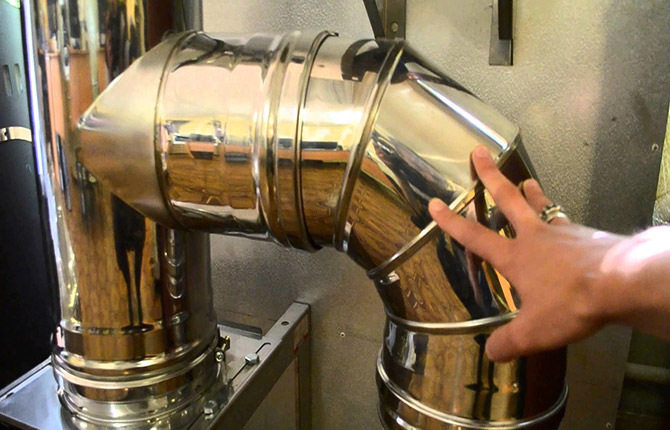









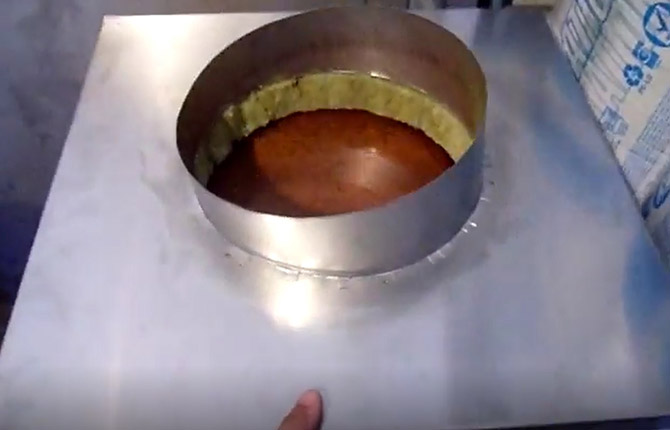
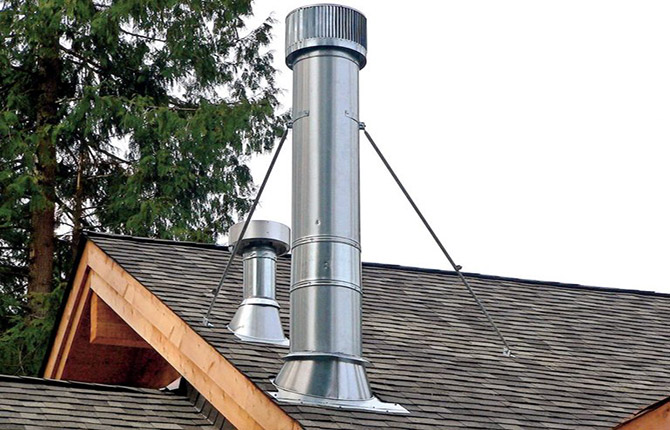

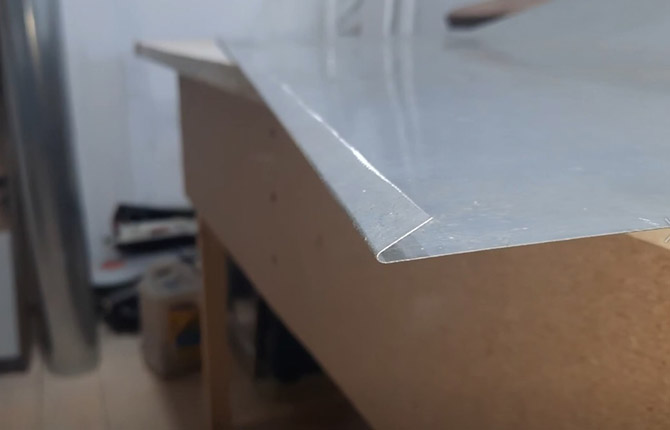
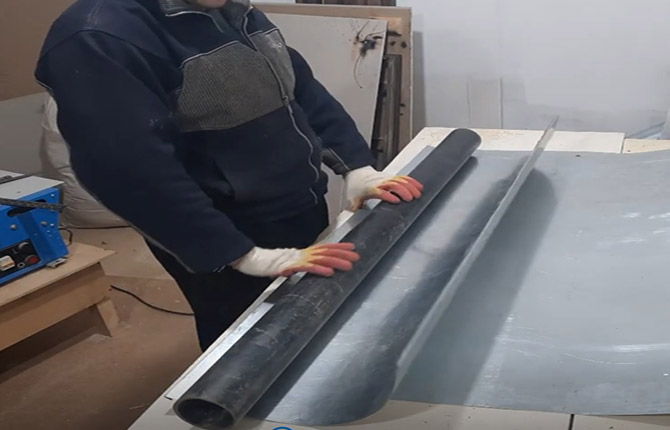



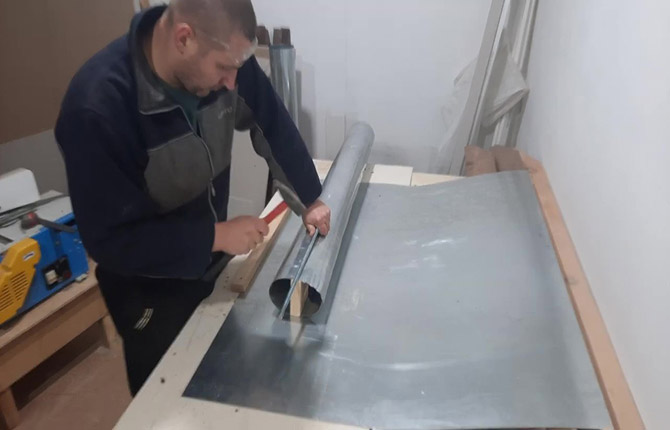

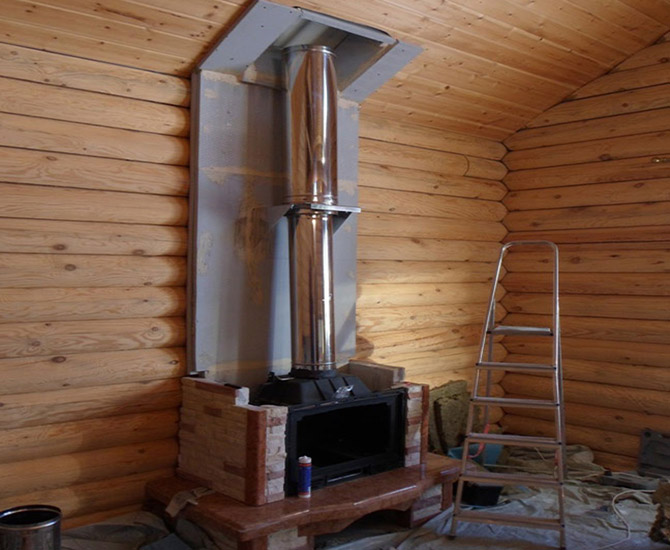




Don't believe the certificates, I bought a dozen and a half sections. All are different colors, you can see that the stainless steel is different. I worked with metal, I know what I'm talking about. The certificate says 306 steel. Experts say that it is generally medical steel. We had to sort by color, the darker ones went to the boiler, the rest to the roof. Twice in five years I removed and welded the seam.
The quality of steel is a problem; previously it was possible to order from Poland, but now Belarusians seem to be bringing good stainless steel. The Chinese are three times cheaper, but there is a risk of not just getting caught for a day, but of burning down the house.Therefore, the chimney is only subject to a contract with the company. Let them do it.